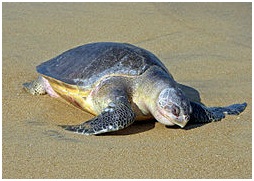
Annual event of nesting of Olive Ridley Turtles
.
Why is it in news?
- In a record, over 4 lakh olive ridleys nest at Rushikulya
Details
- With 4,28,083 mother olive ridley turtles nesting till Monday morning, the endangered species has created an all-time record of mass nesting at the Rushikulya rookery coast in the Ganjam district of Odisha this year. The mass nesting is expected to continue for another two to three days,
- Interestingly, mass nesting of olive ridley turtles has not yet started on the coasts along the Gahirmatha beach and the mouth of the Debi river, two other major nesting sites in Odisha. The Gahirmatha beach is the largest mass nesting site for olive ridley turtles along the Indian coastline, followed by the rookery at the mouth of the Rushikulya river.
- With 3,65,000 nests, olive ridley turtles had created a record of mass nesting at Rushikulya in 2017. They have already broken the record this year, indicating that the environment of this coast continues to be conducive for their mass nesting. In 2016, for some unexplained reason, there was no mass nesting at this coast.
- This year, sea waves and winds have widened a portion of the beach near the Rushikulya rookery. A sandbar near the Podampeta village eroded entirely, and its sand was deposited on the coast, widening a stretch of the beach and increasing its height.
- The turtles have also extended their area of mass nesting northward till the Bateswar temple this year.
About Olive Ridley Turtles
- The olive ridley sea turtle(Lepidochelys olivacea), also known as the Pacific ridley sea turtle, are smallest and most abundant of all sea turtles found in the world, species of sea turtle found in warm and tropical waters, primarily in the Pacific and Indian Oceans. They can also be found in warm waters of Atlantic ocean.
- These turtles, along with their cousin the Kemps ridley turtle, are best known for their unique mass nesting called Arribada, where thousands of females come together on the same beach to lay eggs.
- They are classified as Vulnerable by IUCN and is listed in appendix 1 of CITES.

Source
The Hindu

